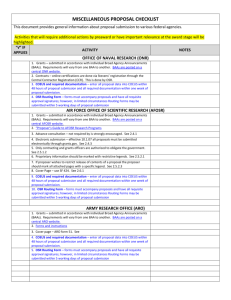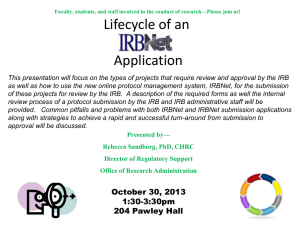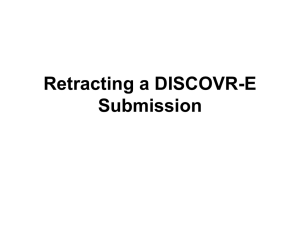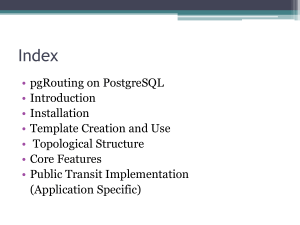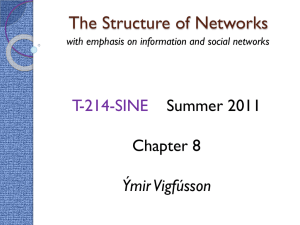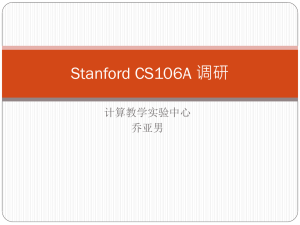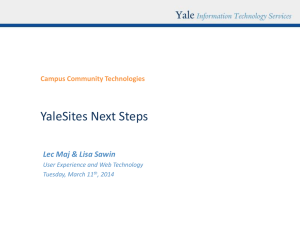Electronic Submission Flow Process for the IRB: Yale University
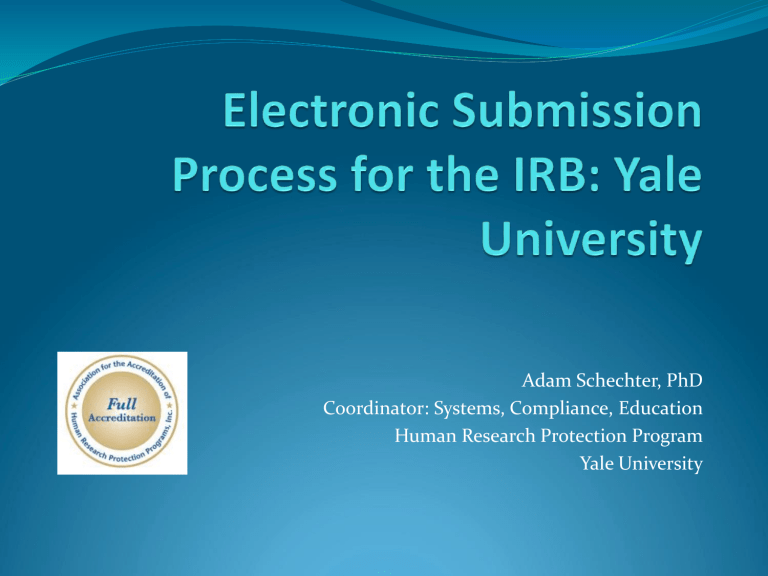
Adam Schechter, PhD
Coordinator: Systems, Compliance, Education
Human Research Protection Program
Yale University
Goals
1.
To identify the main elements of the electronic submission process as it applied to the IRB.
2.
To demonstrate the process for creating routing maps, business rules, and meta-rules.
3.
To show how an institution ’ s particular business practices can be designed in the Coeus system.
4.
To illustrate the Yale experience as an example throughout.
Electronic Submission: The Basics
The main purpose of electronic routing is to simulate an IRB ’ s business practice with paper submissions.
Routing is the process of electronically moving a protocol submission through the various required review components of an institution.
Rules are tests that determine how the submission will be routed.
Initial Swimlanes
At Yale, the established paper submission process involved not only approval from the
HIC, but also approval from other committees and offices external to the HIC. As such, these needed to be incorporated into the electronic routing schema where appropriate:
Example: Yale School of Nursing (Draft)
Maps
Unit Hierarchy
Routing is dependent upon a well-structured hierarchy
Maps
Maps are tied to a unit
Each unit can have multiple maps
Maps
Maps are made up of stops or levels.
Stops are made up of one or more users.
Each level of the unit hierarchy can have maps.
Within the hierarchy each unit ’ s rules will be evaluated and the appropriate maps are inserted into the routing.
Maps
Users are placed in “ stops ” in each map.
Within each stop, users can represent approvers or alternate approvers.
Maps
Maps can utilize multiple levels within which stops and users can be placed by requirement.
Maps
And from the Lite side:
Business Rules
Roles that can setup business rules:
Business Rules Maintainer – Department
System Administrator – Department
Application Administrator – Research Office
Business Rules
Business rules are the nuts and bolts of electronic routing.
They also represent the various components of the swimlane diagram we saw earlier.
When creating a business rule, you can choose from four types:
3.
4.
1.
2.
Notifications
Questions
Routing
Validation
Business Rules
Note that Functions, Questionnaires, and Columns can be used as conditions to build business rules:
Functions: Developed at the database level with the capacity to execute a true/false query and return the result.
Questionnaires: Developed within Coeus by combining (pregenerated) questions and returning user responses.
Columns: Simple values found in specified code tables in Coeus.
Business Rules
Here is an example of a business rule “ shell ” :
Business Rules
As with any logic proof, business rules can be built upon and modified depending on the conditions and functions that are incorporated.
For instance, a very basic business rule might require any protocol submission to be reviewed by a particular group of people (identified by the maps we discussed earlier). In this case, the business rule would look like this:
Business Rules
Note that the function “ All Protocols ” was used in combination with the conditional “ Equal to ” and the truth value “ True ” , along with the selected map “ Triager ” .
In plain-speak, the rule says that whenever any protocol submission is submitted electronically to the IRB, it must be routed to the “ Triager ” map in order to await review by the people associated with that map.
The submission is also routed to each reviewer ’ s inbox along with the basic protocol information and the date of the submission.
Business Rules
If we were to create a business rule with two conditionals, it would look like this:
In plain-speak, this business rule indicates that when a submission is the initial submission for a protocol and a subject population of “ children ” (pre-selected) has been chosen by the investigator, the submission should route to the “ Regulatory/PPRC
Scientific Review ” map.
Business Rules
And from the Lite side:
+
=
Business Rules
Business Rules
If we add the previous two conditionals together, we get the following “ if-then ” business rule:
Again, in plain-speak, this indicates that if a submission meets the criteria for
“ Test Rule 2 ” (first submissions and children, it should route to the
“ Regulatory/PPRC Scientific Review ” map. Otherwise, all submissions
(including those in Test Rule 2) should be routed to the “ Triager ” map.
Meta-Rules
Once business rules have been established within a particular route, meta-rules can be used to organize and prioritize them as necessary.
At least one business rule must be present in order for a meta-rule to be created for a unit.
A unit can only have one meta-rule for each type of rule
(Notifications, Questions, Routing, Validation).
Three “ Rule Criteria ” are used in the creation of metarules: “ Next ” , “ If True ” , and “ If False ” .
Meta-Rules
For example, choose which of your available business rules will serve as the “ Parent Node ” (i.e., the first one used):
Meta-Rules
Next, follow the same procedure for “ Child Nodes ” , each of which should exist in a pre-determined order under the Parent Node, following the logic of the
Rule Criteria.
So, if a node is selected with “ Next ” as the criterion, it will automatically follow the previous node without any assessment of truth value. “ If True ” and “ If
False ” will verify truth value before sending the submission to the next node, accordingly:
Testing
As always, testing is extremely important to the development of a good routing schema.
The more a tester can mimic the possible actions of both Lite and
Premium users, the more confident she can be that the routes will work as expected once they hit prime time.
In this way, having clearly defined roles (user, administrator, approver, etc.) for each of the testers involved can only help ensure that the test will be as successful as possible.
It is also important to have as many of the “ real world people ” as possible involved in the testing process. For instance, if an external review committee will be reviewing protocol submissions involving children, inviting actual reviewers from that committee to participate in the route tests will both emulate the Production instance and provide de facto training for the reviewers as well.
Education & Trainings
There are three main groups to focus on when providing training for newly-created routes:
1.
2.
3.
Department Users (Research Community, Lite)
Technical Users (IRB Administrators, Premium)
Tangential Users (External Committee Approvers, Both)
Each group requires a carefully tailored explanation not only of the technical “ how-to ’ s ” involved in the routing functionality, but also of their respective roles in the bigger picture of the electronic submission process.
Education & Trainings
A variety of materials can be used for good education. Here is a (non-exhaustive) list of some effective ones:
Comprehensive manuals for administrators and end users.
Quick guides offering abbreviated “ how-to ” instructions on individual topics.
Correspondence (usually by email) to the community at large notifying them of the pertinent details of the release.
Large group training sessions with the purpose of outlining the updates/changes/enhancements forthcoming.
Small group training sessions with the purpose of offering individualized assistance for users.
Multimedia-based presentations or training sessions offered on a website.
Education & Trainings
Yale ’ s HRPP utilizes all of the above methods for training where possible. Here is an example of the website we use to provide our end users with updated information and training materials:
Go-Live!
Once it is clear that the electronic route is accurate and the potential users are trained, the route can be placed into
Production.
A good method for “ testing ” while in Production is to begin routing with a Pilot group first. This may require initial and subsequent refinements to the various components we ’ ve discussed so far.
Keep in mind that as user groups grow, office procedures change, and system enhancements are released, routing should be viewed as a malleable process. Don ’ t assume that because your routes work now, they will work without tweaking for years on end.
Thanks!
Adam Schechter, PhD
Coordinator for Systems, Compliance, & Education
Human Research Protection Program
Yale University adam.schechter@yale.edu
(203) 737-5564

